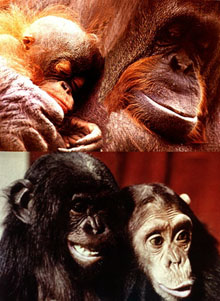 In terms of our cultural roles, however, individual humans can specialize to a remarkable extent. Here again, our cultures take us beyond the limitations of our biology.
In terms of our cultural roles, however, individual humans can specialize to a remarkable extent. Here again, our cultures take us beyond the limitations of our biology.The Physical Characteristics of Humans
- Page 22 -
 In terms of our cultural roles, however, individual humans can specialize to a remarkable extent. Here again, our cultures take us beyond the limitations of our biology.
In terms of our cultural roles, however, individual humans can specialize to a remarkable extent. Here again, our cultures take us beyond the limitations of our biology.
In some of the great apes that do not have this characteristic, the differences between juvenile and adult forms of the same species are quite striking – perhaps nowhere more obviously than in the orangutan, at left. This mother and her offspring are very different in appearance; male orangutans go through even more striking developmental changes as they mature.
Using this general concept of mammalian development, we can easily identify the juvenile chimp from the adult in the photo below left. The more mature chimp is on the right. Correct?
Actually, this is not the case. The general rule does not work in this instance, because this is a “trick question” to illustrate a point about neoteny. Both chimps in the picture at left are the developmental equivalent of human teenagers, but one of them, the smaller, younger-looking one on the left, is a pigmy chimp or bonobo. This species, the ape most closely related to humans in terms of similarities in DNA, is also characterized by neoteny. Bonobos retain their juvenile features into adulthood, just as we do. In fact, they resemble us in many ways.